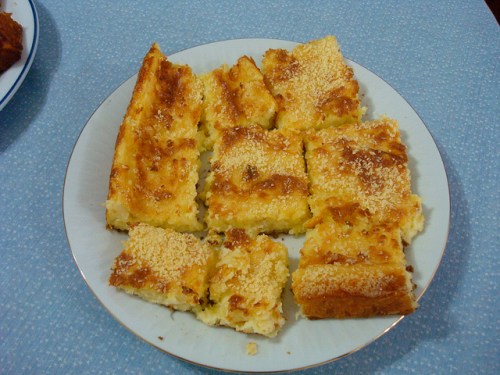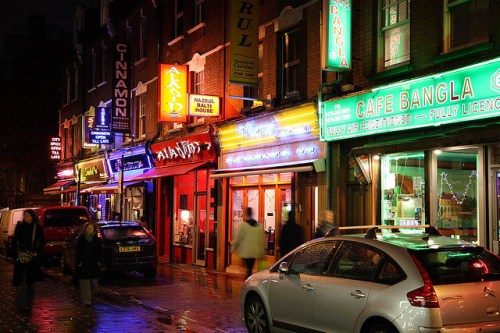 Nigeria is competing for the first time this year in the 2018 PyeongChang Winter Olympics, with a bobsled team composed of Nigerian-Americans. Though bobsledding may not get a lot of press in Nigeria, we wanted to highlight this country and its food. So what is the most representative Nigerian national dish? A poll conducted this year by Pulse Magazine had readers selecting Jollof rice, whereas a poll done previously by CNN had them selecting Egusi soup. Well, we are definitely not informed enough to weigh in, so we figured we’d highlight each of these national dish rivals.
Nigeria is competing for the first time this year in the 2018 PyeongChang Winter Olympics, with a bobsled team composed of Nigerian-Americans. Though bobsledding may not get a lot of press in Nigeria, we wanted to highlight this country and its food. So what is the most representative Nigerian national dish? A poll conducted this year by Pulse Magazine had readers selecting Jollof rice, whereas a poll done previously by CNN had them selecting Egusi soup. Well, we are definitely not informed enough to weigh in, so we figured we’d highlight each of these national dish rivals.

Jollof Rice by Joan Nova
Jollof rice is a rice-based dish made with tomatoes, tomato paste, onions, hot peppers and spices, usually served with some kind of protein. Popular throughout West Africa, the recipe for Jollof Rice varies wildly depending on where you are. And of course, each country thinks that they have the best Jollof rice, and it has inspired years of heated debate (and even a rap song). In Nigeria, the dish is also typically accompanies by fried plantains and moin moin, a spicy side made from black eyed peas. You can find recipes for Jollof rice from All Nigerian Recipes, Sisi Jemimah and Ev’s Eats.

Goat Egusi with fufu by HC
Egusi soup doesn’t have as wide of a range in Africa, and is made from the ground seeds of Egusi melon, palm oil, dried fish, and leafy greens (in many cases bitterleaf). Unlike Jollof rice, Egusi may be a little harder to find, unless you live by a Nigerian market, but thank goodness for the internet. Egusi soup is usually served with fufu (boiled and pounded cassava) that helps sop up the soup. You can find recipes for Egusi soup at Demand Africa, All Nigerian Recipes, and All Nigerian Foods. Though we have tried both of these dishes, our hearts are with Jollof rice, one of our favorite West African dishes, yum! Of course, Nigerian cuisine is is full of delicious dishes, so don’t stop with just these two.

 It’s was
It’s was 
 For the final country represented on the
For the final country represented on the When researching the national dish of the Democratic Republic of the Congo, one of the countries represented on the
When researching the national dish of the Democratic Republic of the Congo, one of the countries represented on the 
 This is the first time that South Sudan (which only
This is the first time that South Sudan (which only 
 For the first time in the history of the Olympics, a team composed of refugees is competing under their own banner. The 10 athletes representing the Refugee Olympic Team hail from
For the first time in the history of the Olympics, a team composed of refugees is competing under their own banner. The 10 athletes representing the Refugee Olympic Team hail from  Kosovo,
Kosovo, 



 East Timor is one of the world’s youngest counties, established only in 2002. However, it is already sending its first athlete to the winter Olympics, skier Yohan Goutt-Goncalves. Seafood is key in the national diet in this island nation, and culinary influence from Portugal and Indonesia is strongly felt. The national dish of East Timor is Ikan Pepes / Pepes Ikan (Ikan means ‘fish’ and pepes is the cooking technique), fish steamed with chili sauce in a banana leaf. Sounds pretty good! Here are two recipes for Ikan Pepes from
East Timor is one of the world’s youngest counties, established only in 2002. However, it is already sending its first athlete to the winter Olympics, skier Yohan Goutt-Goncalves. Seafood is key in the national diet in this island nation, and culinary influence from Portugal and Indonesia is strongly felt. The national dish of East Timor is Ikan Pepes / Pepes Ikan (Ikan means ‘fish’ and pepes is the cooking technique), fish steamed with chili sauce in a banana leaf. Sounds pretty good! Here are two recipes for Ikan Pepes from 
 Malta, a Mediterranean island nation. has one competitor in their debut Olympics, skier Elise Pellegrin. Malta’s cuisine is influenced by France, Spain, Italy and even England. The national dish of the country is Stuffat Tal-Fenek, a stewed rabbit dish in a red wine an tomato sauce. Apparently rabbit is hugely popular in Malta, and a dinner where rabbit is consumed is called a fenkata.
Malta, a Mediterranean island nation. has one competitor in their debut Olympics, skier Elise Pellegrin. Malta’s cuisine is influenced by France, Spain, Italy and even England. The national dish of the country is Stuffat Tal-Fenek, a stewed rabbit dish in a red wine an tomato sauce. Apparently rabbit is hugely popular in Malta, and a dinner where rabbit is consumed is called a fenkata. 
 This year, Winter Olympics newcomer Togo has two athletes competing in Sochi, skiiers Alessia Afi Dipol and Mathilde-Amivi Petitjean. We were also super interested to learn that there was a
This year, Winter Olympics newcomer Togo has two athletes competing in Sochi, skiiers Alessia Afi Dipol and Mathilde-Amivi Petitjean. We were also super interested to learn that there was a 
 Zimbabwe is competing in the Winter Olympics for the first time in Sochi, with Alpine skiier Luke Steyn, and we are excited to learn more about the country’s national dish and cuisine. The national dish of Zimbabwe is widely considered to
Zimbabwe is competing in the Winter Olympics for the first time in Sochi, with Alpine skiier Luke Steyn, and we are excited to learn more about the country’s national dish and cuisine. The national dish of Zimbabwe is widely considered to 
 Second in our series on winter Olympic newcomer cuisines is Paraguay. The athlete representing Paraguay is an American citizen of Paraguayan heritage,
Second in our series on winter Olympic newcomer cuisines is Paraguay. The athlete representing Paraguay is an American citizen of Paraguayan heritage, 




 The first in our Winter Olympics newcomer series is Tonga. The sole athlete from Tonga is certainly making waves at their first Winter Olympics, the luger, born Fuahea Semi , now
The first in our Winter Olympics newcomer series is Tonga. The sole athlete from Tonga is certainly making waves at their first Winter Olympics, the luger, born Fuahea Semi , now

 What did you think of the Opening Ceremony? With the 2014 Sochi Winter Olympics officially under way, we are in full Russian food mode. We are not experts in Russian food, but we have trying to learn more about the country’s different regional and local specialties. We’ve done a little research in preparation for a Russian dinner party in honor of the Sochi Olympics, to get a little beyond
What did you think of the Opening Ceremony? With the 2014 Sochi Winter Olympics officially under way, we are in full Russian food mode. We are not experts in Russian food, but we have trying to learn more about the country’s different regional and local specialties. We’ve done a little research in preparation for a Russian dinner party in honor of the Sochi Olympics, to get a little beyond 




